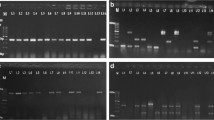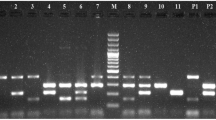Abstract
This study was designed to identify if the heat-labile enterotoxin (LT)-, heat-stable enterotoxin (ST)a- and STb-encoding genes are detectable in faecal samples from different healthy hosts and also on which part of the genome (chromosome or plasmid) they are located. Seventy-five samples of Escherichia coli were isolated from dog, sheep and poultry faecal samples (25 from each host). Plasmid and chromosomal DNA were extracted and polymerase chain reaction performed on all plasmid and chromosomal DNA using LT, STa and STb primers. Additionally, the plasmid profile of all E. coli isolates was defined using gel electrophoresis. The results showed that 36% of the E. coli isolates possessed genes for the production of LT toxin. All samples were negative for STa and STb genes. The plasmid profile of different hosts showed that all samples harboured plasmids. The results of this study indicate that enterotoxigenic E. coli are present in the faeces of different hosts. Since the genes encoding for LT and ST toxins reside on plasmids, or occasionally on transposons, they may transfer among the Gram-negative bacteria especially to the enterobacteriaceae family including E. coli which then may infect other hosts, for example, humans.






Similar content being viewed by others
References
Ahmadi M (2005) Study on transfer of drug resistance factors among Escherichia coli isolated from chicken farms of Urmia. J Fac Vet Med Univ Tehran 60(1):71–77
Alexander TJL (1994) Neonatal diarrhoea in pigs. In: Gyles CL (ed) Escherichia coli in domestic animals and humans. CAB International, Wallingford, pp 151–170
Anderson ES, Dalta N (1965) Resistance to penicillins and its transfer in enterobacteriaceae. Lancet 1:407–409. doi:10.1016/S0140-6736(65) 90004-8
Ausubel FR, Brent RE, Kingston DD, Moore JG, Seidman JA, Smith A, Struhl K (1995) Short protocols in molecular biology. A compendium of methods from current protocols in molecular biology. Wiley, New York
Black RE, Brown KH, Becker S, Abdul Alim ARM, Merson MH (1982) Contamination of weaning foods and transmission of enterotoxigenic Escherichia coli diarrhoea in children in rural Bangladesh. Trans R Soc Trop Med Hyg 76:259–264. doi:10.1016/0035-9203(82) 90292-9
Dombek PE, Johnson LK, Zimmerely ST, Sadowsky MJ (2000) Use of repetitive DNA sequences and the PCR to differentiate Escherichia coli isolates from human and animal sources. Appl Environ Microbiol 66:2572–2577. doi:10.1128/AEM.66.6.2572-2577.2000
DuPont HL, Formal SB, Hornick RB, Snyder MJ, Libomati JP, Sheahan DG, La Brec EH, Kalas JP (1971) Pathogenesis of Escherichia coli diarrhoea. N Engl J Med 285:1–9
Flint HJ, Duncan SH, Styewart CS (1987) Transmissible antibiotic resistance in strains of Escherichia coli isolated from the ovine rument. Appl Microbiol 5:47–49
Guardabassi L, Schwarz S, Lloyd DH (2004) Pet animals as reservoirs of antimicrobial- resistant bacteria. J Antimicrob Chemother 54:321–332. doi:10.1093/jac/dkh332
Kayvanfar H, Firouzi R (1998) Transfer of antibacterial resistance among Salmonella isolates from diarrhoea of calves around Shiraz. J Fac Vet Med Univ Tehran 52(3):45–48
Levine MM (1987) Escherichia coli that cause diarrhoea: enterotoxigenic, enteropathogenic, enteroinvassive, enterohemorrhagic, and enteroadherent. J Infect Dis 155:377–389
Martinez LY, Arenas MMP, Montes MYR, Martinez LJ, Baca BE (1987) Antibiotic resistance and plasmid pattern of enterotoxigenic ST-a strains of Escherichia coli isolated in Puebla, Mexico. Can J Microbiol 33:816–819
Meyers JA, Sanchez D, Elewell O (1976) Simple agarose gel electrophoretic method for the identification and characterization of plasmid deoxyribonucleic acid. J Bacteriol 127:1529–1537
Nataro JP, Kaper BJ (1998) Diarrheagenic Escherichia coli. Clin Microbiol Rev 11(1):142–201
Ojeniyi B, Ahrens P, Meyling A (1994) Detection of fimberial and toxin genes in Esherichia coli and their prevalence in piglets with diarrhoea. The application of colony hybridization assay, polymerase chain reaction and phenotypic assays. J Vet Med 41:49–59
Osek J, Gallien P, Truszczynski M, Protz D (1999) The use of polymerase chain reaction for determination of virulence factors of Escherichia coli isolated from pigs in Poland. Comp Immunol Microbiol Infect Dis 22:163–174. doi:10.1016/S0147-9571(98) 00083-6
Quinn PJ, Markey BK, Carter ME (2002) Veterinary microbiology and microbial disease. Blackwell Science, London
Rezina L, Abdul Hey Khan MD, Ashik Mosaddik M (2001) Study of Antimicrobial Susceptibility and Plasmid analysis of Escherichia coli in Rajshahi, Bangladesh. Sciences (New York) 1(3):137–140
Ryder RW, Sack DA, Kapikian AZ, McLaughlin JC, Chakraborty J, Mizanur Rahman AS, Merson MH, Wells JG (1976) Enterotoxigenic Escherichia coli and retrovirus-like agent in rural Bamgladesh. Lancet 1:650–663
Savarina SJ, Mc Veigh, Watson J, Motina J, Cravioto A, Echeverria P, Bhan MK, Levine MM, Fasano A (1996) Enteroaggregative Escherichia coli heat-stable enterotoxin is not restricted to enteroaggregative Escherichia coli. J Infect Dis 173:1019–1022
Schultsz C (1994) Detection of enterotoxigenic Escherichia coli in stool samples by using non-radioactively labelled oligonucleotide DNA probs and PCR. J Clin Microbiol 1994:2393–2397
Sixma TK, Kalk KH, Van Zanten BA, Dauter Z, Kingma J, Witholt B, Hot WG (1993) Refined structure of Escherichia coli heat labile enterotoxin, a close relative of cholera toxin. J Mol Biol 230:890–918. doi:10.1006/jmbi.1993.1209
Stacy-Phipps S, Mecca JJ, Weiss JB (1995) Multiplex PCR assay and simple preparation method foe stool specimens detect enterotoxigenic Escherichia coli DNA during the course of infection. J Clin Microbiol 33:1054–1059
Taylor J, Wilkins MP, Payne JM (1961) Relation of rabbit gut reaction to enteropathogenic Escherichia coli. Br J Exp Pthology 42:43–52
Tornieporth NG, John J, Salgado K, De jesus P, Latham E, Melo MC, Gunzburg ST, Riley LW (1995) Differentiation of pathogenic Escherichia coli strains in Brazilian children by PCR. J Clin Microbiol 33:1371–1374
Vu-Khac H, Holoda E, Pilipcinec E (2004) Distribution of virulence genes in Escherichia coli strains isolated from diarrhoeic piglets in the Slovac Republic. J Vet Med 51:343–347
Wachsmuth IK, Deboy J, Birkness K, Sack D, Wells J (1993) Genetic transfer of antimicrobial resistance and enterotoxigenicity among Escherichia coli strains. Antimicrob Agents Chemother 23:278–285
Wang Z, Rossman TG (1994) Large scale supercoiled plasmid preparation by acidic phenol extraction. Bio Techniques 16:460–463
Wood LV, Ferguson P, Hogna D, Thrman D, Morgan HL, Ericsson CD (1983) Incidence of bacterial enteropathogens in foods from Mexico. Appl Environ Microbiol 46:328–332
Yamamato T, Echeverria P (1996) Detection of the enteroaggregative Escherichia coli heat-stable enterotoxin 1 gene sequences in enterotoxigenic E. coli strains pathogenic for humans. Infect Immun 64:1441–1445
Acknowledgment
This work was supported by the research fund from Urmia University, Urmia, Iran.
Author information
Authors and Affiliations
Corresponding author
Rights and permissions
About this article
Cite this article
Ahmadi, M., Mardani, K., Airemlou, N. et al. Detection of LT and ST genes in the Escherichia coli isolated from the dogs, sheep and poultry. Comp Clin Pathol 18, 407–412 (2009). https://doi.org/10.1007/s00580-009-0825-8
Received:
Accepted:
Published:
Issue Date:
DOI: https://doi.org/10.1007/s00580-009-0825-8




